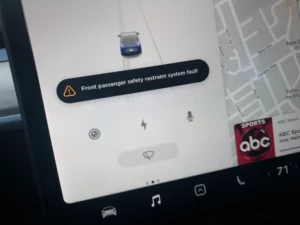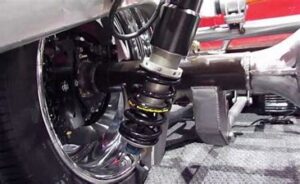The front passenger safety restraint system fault is a hidden worry among the maze of wires and technology that makes our automobiles safer. Imagine yourself driving down the road, confident that your vehicle is a haven that will keep you safe in the event of an accident. But beyond the surface, there might be a flaw that could jeopardize this haven. This malfunction is caused by a strange problem with the front passenger safety restraint system, which can exist in the core of our cars.
This article explores the world of safety features that we frequently take for granted. It explains what a safety restraint system failure entails, how silent it is, and what threats it might provide. We’ll explain the intricacies of this problem in simple words, from broken wiring to distinct sensors. More significantly, we’ll walk you through workable fixes for these issues so that your car’s unseen safety net continues to be strong and dependable. Come along on this adventure to understand the front passenger safety restraint system defect and discover safe travel practices.
Table of Contents
Understanding The Front Passenger Safety Restraint System Fault
A malfunction with the components intended to protect the occupant of the front passenger seat in an automobile during a collision is referred to as a front passenger safety restraint system defect. Airbags and seat belts are two components of this safety system that work in tandem to lessen the force of a collision. A malfunction indicates that something isn’t operating as it should, which could compromise the efficacy of these safety precautions. This problem may be caused by several things. This includes worn-out sensors that are meant to sense the force of an impact.

Moreover, defective wiring obstructs communication within the system. As well as the bugs in the software that regulates safety features, or just general wear and tear on the system’s parts over time. To fix this issue, routine maintenance inspections, problem-solving with diagnostic tools, software updates, component replacement, and staying up to date on manufacturer recalls are all necessary. It’s critical to fix these issues as soon as possible to maintain the dependability and efficiency of the safety mechanisms meant to protect passengers.
Common Causes Of Front Passenger Safety Restraint System Faults: Unraveling The Mystery In Simple Terms
The front passenger safety restraint system is like a superhero outfit for your car, ready to protect you in case of danger, in the complicated world of automobiles and its safety features. But even superheroes have difficulties from time to time. Let’s investigate the typical reasons for the enigmatic “front passenger safety restraint system fault” in automobiles.

1. Sensor Differenctures:
Consider sensors as the feelers of the car; they detect the force of an impact and alert the safety system to initiate action. Your safety superhero may become perplexed and fail to activate the necessary safety precautions when these sensors malfunction or begin to send out incorrect indications.
2. Hide & Seek With Wires:
Consider the safety system as a network of wires for communication. Now, the messages they convey about a crash may not reach the correct places if some of these cables decide to play hide and seek or sustain damage. It resembles a telephone game gone awry, resulting in a breakdown in the safety strategy.

3. Software Bugs:
Software controls everything in today’s tech-savvy autos, just like the brain does. But, issues can occasionally arise, just like with our home computers. The safety precautions may become ineffective if the software that controls the safety systems begins to malfunction.
4. Wear And Tear:
Not even the components in your car stay forever. The safety system’s parts are susceptible to wear and tear over time, particularly if they have experienced many ups and downs (literally). Parts that are worn out may not function as well, endangering your safety.
Therefore, knowing these typical causes is like performing a routine health check on your car. Getting an expert to look at it is a good idea if you see anything strange or if it has been a long since your last auto check-up. Maintaining your front passenger safety restraint system regularly and addressing problems early on will guarantee that it is always prepared to take action when you need it most. All of us want our cars to be dependable roadside protectors, after all.
Solutions To Fix The Front Passenger Safety Restraint System Defect
It’s critical to respond quickly if the front passenger safety system in your automobile malfunctions. Find quick fixes for these issues so your car can continue to be a shield for you on the unpredictably winding roads ahead.

1. Frequent Examinations:
Regular inspections are necessary for your car, just as they are for us when we go to the doctor. Be sure to adhere to the recommended servicing schedule provided by the car manufacturer. This aids in the early detection of any possible issues with the safety restraint system.
2. Employ Diagnostic Instruments:
Tools used by mechanics serve as automobile detectives. These instruments can identify the precise cause of the safety system’s malfunction. These tools assist in identifying the problem, whether it be a malfunctioning sensor or a wire acting strangely.
3. Change Out Worn-Out Parts:
Consider replacing your worn-out shoes with new ones for increased comfort. Likewise, replace any worn-out or damaged parts of the safety system. This could involve wires, sensors, or additional parts. Your safety system will function as intended if you use new, authentic parts.
4. Upgrade The Vehicle’s Software:
Like phones or computers, cars are getting increasingly intelligent. For improved performance, they occasionally require software updates. Pay attention to any changes provided by the vehicle manufacturer. Bugs in the safety system of your car can be fixed by updating the software.
5. Participation In Recall:
The automaker may request that you bring your vehicle in for maintenance if they discover a widespread issue with their vehicles. We refer to this as a recall. Recalls must always be followed; it’s similar to giving your car an annual vaccination to keep it safe.
Ultimately, maintaining the health of your car is similar to repairing a defect in the front passenger safety restraint system. The keys are routine check-ups, correcting what’s broken, and keeping software updated. Keep in mind that your car’s safety system acts as your protector while you’re driving; make sure it’s constantly prepared to keep you safe.
Conclusion:
Although the front passenger safety restraint system is an essential defence against road hazards. However, it is prone to malfunctions that require our attention. To make sure that this complex safety net continues to function dependably, it is imperative to comprehend the possible causes of the front passenger safety restraint system fault and put preventative maintenance and repair procedures into place. It is up to us as car owners to balance innovation with safety in a way that keeps our travels both cutting-edge and, most importantly, safe. We must be watchful and proactive in this regard.



